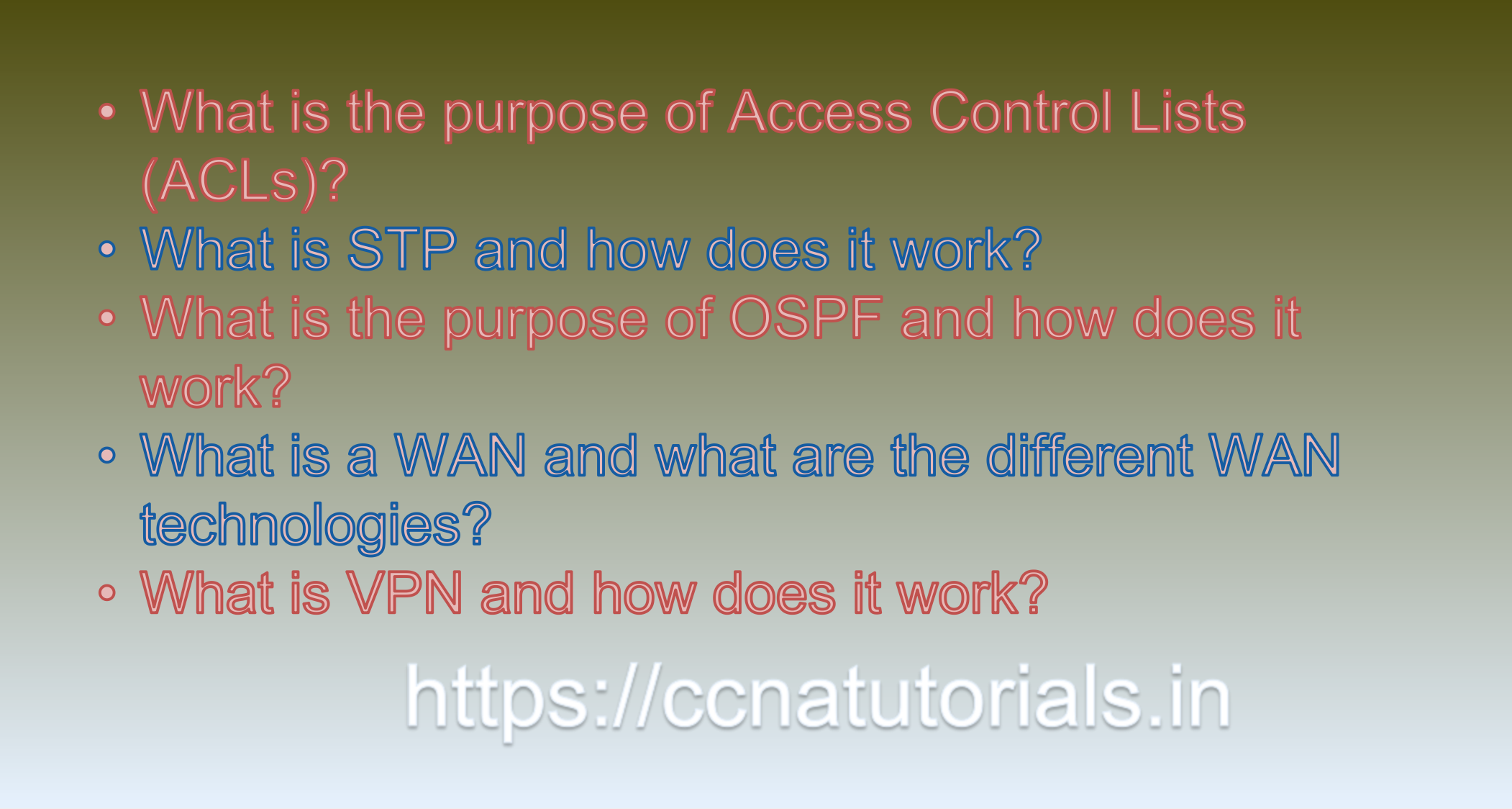Contents of this article
In this article, I describe some CCNA sample questions for practice before appearing in the CCNA 200-301 exam. The following questions are basic questions and related to the CCNA sample questions set 3. There are multiple sample questions set on this website for prior practice online. All questions are described with relevant answers. You can take the following questions and answer as reference for CCNA 200-301 exam. You may also need to do more practice with other websites and books to practice the CCNA sample questions set 3.
Question 1: What is the purpose of Access Control Lists (ACLs)?
Access Control Lists (ACLs) are a mechanism used to control network traffic by allowing or denying access to network resources based on a set of rules. ACLs are used to define the permissions that users or network devices have to access specific resources on a network.
Here are some examples of how ACLs can be used:
Restricting Access: ACLs can be used to block access to specific resources on a network, such as websites, servers, or specific types of traffic. This can be useful for enforcing security policies and preventing unauthorized access to sensitive information.
Controlling Traffic: ACLs can be used to control traffic flow on a network, such as limiting the amount of traffic that can be sent or received on a particular port or interface.
Prioritizing Traffic: ACLs can also be used to prioritize traffic on a network, such as giving priority to critical applications or services.
Logging Traffic: ACLs can be used to log network traffic for troubleshooting and auditing purposes.
ACLs can be applied to network devices such as routers, switches, and firewalls. They typically include a set of rules that specify the conditions under which traffic is allowed or denied. For example, an ACL rule might allow traffic from a specific IP address or deny traffic from a certain port.
ACLs are an important part of network security and can help to prevent unauthorized access to network resources. They can also be used to improve network performance by controlling traffic flow and prioritizing critical applications or services. This is the answer to question 1 of CCNA sample questions set 3.
Question 2: What is STP and how does it work?
STP, or Spanning Tree Protocol, is a networking protocol used to prevent network loops in a LAN (Local Area Network) topology. A network loop occurs when there are multiple paths between network devices, which can cause packets to circulate indefinitely, consuming network resources and degrading network performance. STP solves this problem by identifying and disabling redundant links in the network topology, leaving only the active links in use.
Here’s how STP works:
Electing a Root Bridge: STP identifies a single root bridge in the network, which serves as the reference point for all other devices. The root bridge is chosen based on a set of criteria, such as the device with the lowest MAC address.
Building the Spanning Tree: Once the root bridge is elected, STP uses a process called the spanning tree algorithm to identify and disable redundant links in the network topology. The algorithm creates a logical tree structure that spans all network devices, ensuring that there is only one active path between any two devices.
Blocking Redundant Links: STP disables redundant links in the network topology by putting them into a blocking state. Blocked links still receive STP messages and maintain their configuration, but they don’t participate in forwarding network traffic. This prevents network loops and ensures that packets are forwarded only along active paths.
Reacting to Changes: STP continuously monitors the network topology and reacts to changes by recalculating the spanning tree. If a link or device fails, STP recalculates the spanning tree to ensure that there is still only one active path between any two devices.
STP is a widely used protocol in LAN environments because it provides a simple and effective way to prevent network loops and ensure network performance. However, STP can have some limitations in larger networks, such as slow convergence times and suboptimal network paths. To address these issues, newer protocols such as Rapid Spanning Tree Protocol (RSTP) and Multiple Spanning Tree Protocol (MSTP) have been developed. This is the answer to question 2 of CCNA sample questions set 3.

Question 3: What is the purpose of OSPF and how does it work?
OSPF (Open Shortest Path First) is a popular interior gateway protocol (IGP) used to facilitate communication between routers within a single autonomous system (AS) or network. Its primary purpose is to determine the best path for data packets to travel from one router to another within the same network.
OSPF operates by constructing a topology map of the network, which includes all of the routers and their connections, and then using this map to calculate the shortest path between any two routers. This is accomplished by assigning a cost to each link based on its bandwidth and other factors, such as delay or reliability. Once the cost of all links has been determined, the router can use this information to calculate the shortest path to any destination in the network using a link-state algorithm.
OSPF also provides mechanisms for detecting changes in the network topology, such as when a router goes down or a new router is added. When a change is detected, OSPF routers can quickly update their topology maps and recalculate the shortest path, ensuring that data packets continue to flow smoothly through the network.
OSPF is designed to provide efficient and reliable routing within a single network by calculating the shortest path between routers and detecting changes in the network topology to ensure that data packets are always delivered to their intended destinations. This is the answer to question 3 of CCNA sample questions set 3.
Question 4: What is a WAN and what are the different WAN technologies?
WAN stands for Wide Area Network, which is a type of computer network that spans over a large geographical area, often connecting multiple smaller networks together. WANs are used to interconnect different locations such as offices, data centers, and remote users across the world. WAN technologies are the various means by which data is transmitted across a WAN.
Some of the commonly used WAN technologies are:
Leased Lines: A dedicated point-to-point connection that provides a fixed bandwidth between two locations.
Frame Relay: A packet-switching technology that transmits data in variable-length packets called frames. Frame Relay networks are typically used by businesses to connect LANs at different locations.
ATM (Asynchronous Transfer Mode): A cell-switching technology that transmits data in fixed-size cells. It is commonly used for multimedia applications and voice over IP.
MPLS (Multiprotocol Label Switching): A packet-switching technology that uses labels to direct data along predetermined paths through the network. MPLS is often used by service providers to offer VPN services.
VPN (Virtual Private Network): A technology that uses encryption to securely transmit data over a public network such as the Internet. VPNs are often used to provide remote access to corporate networks.
Satellite: A wireless technology that uses orbiting satellites to transmit data between two locations. Satellite networks are often used in remote areas where wired connections are not available.
4G/5G: A wireless technology that provides high-speed internet connectivity over cellular networks. 4G and 5G are widely used to provide mobile internet connectivity, but can also be used as a backup for wired connections in some cases.
Each of these WAN technologies has its own advantages and disadvantages, and the choice of technology depends on factors such as cost, reliability, bandwidth requirements, and availability in the specific location. This is the answer to question 4 of CCNA sample questions set 3.
Question 5: What is VPN and how does it work?
VPN stands for Virtual Private Network, which is a technology that allows users to create a secure and encrypted connection over a public network such as the Internet. The purpose of a VPN is to provide a secure and private communication channel between two devices or networks that are geographically separated.
A VPN works by creating a virtual tunnel between the user’s device and a remote server, which acts as a gateway to the internet. The data transmitted through this tunnel is encrypted, making it difficult for anyone to intercept or eavesdrop on the communication.
When a user connects to a VPN, their device establishes a secure connection with the remote server, and all of their internet traffic is routed through this connection. This means that their internet service provider (ISP) or any other third-party cannot see their online activity, including the websites they visit, the data they send or receive, or their location.
The encryption used in VPNs is usually done using one of several protocols, such as PPTP, L2TP/IPSec, OpenVPN, or SSTP. Each protocol has its own strengths and weaknesses in terms of security, speed, and compatibility with different devices and operating systems.
VPNs provide a secure and private communication channel over a public network by encrypting the data transmitted between two devices or networks. This helps to protect users’ privacy, prevent data theft or interception, and enable remote access to private networks. This is the answer to question 5 of CCNA sample questions set 3.
Conclusion for CCNA sample questions set 3
In this article, I described 5 questions with answers related to CCNA 200-301 exam. I hope you found these questions helpful for the practice of the CCNA 200-301 exam. You may drop a comment below or contact us for any queries related to the above questions and answers for CCNA 200-301. Share the above questions If you found them useful. Happy reading!!






